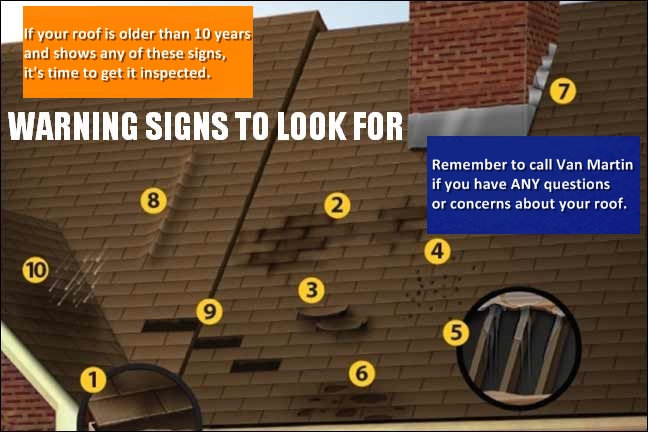Inspecting Your Dayton Roof: 10 Signs of Damages
What Are We Looking At!
We’re constantly urged to check our roofs at least twice a year (once in the spring and once in the fall). We’re told to make sure there aren’t any buckling shingles or streaks of algae. But what do these things look like? Most people aren’t experts in roof inspections and shouldn’t be expected to distinguish red flags for repair or replacement from simple wear and tear.
Below is a helpful graphic to help you identify different signs of damage.

1. Missing Granules
A common sight on older shingles, which often indicate a need for replacement.
2. Algae
The result of the growth of air-borne algae, which deposits on your roof. Homes with more shade and asphalt shingles are more susceptible. Also, Dayton, Ohio is a great climate for roof algae.
3. Curling
Caused by a lack of ventilation or an improper number of fasteners.
4. Blisters
A sign of moisture in the shingle.
5. Ceiling Spots
A very good indicator of a roof leak.
6. Rotting
Absorption of moisture by the mat at the core of the shingle.
7. Damaged Flashing
A sign of drying and cracking.
8. Buckling
The result of poor roof ventilation or new shingles that were applied over the old shingles.
9. Missing Shingles
Caused by improper fastening and/or exposure to high winds.
10. Hail Damage
It causes missing granules and roof leaks.
It’s All About Maintenance:
Inspecting a roof may not be an exciting home project, but the top of our homes deserves proper maintenance for a variety of reasons. Roof repairs are essential for curbing high energy bills and avoiding extensive water damage from leaks and more costly fixes.
Be proactive about your roof. If you’ve detected any of the above damages, give us a call at 222-7885 or Click Here.
Cleaning tips: Once a year, you should clean the cobwebs and dust from your ventilation system and exhaust vents. Then, caulk with a high-grade sealant around pipes and vents and paint any exposed metal to prevent rust. Also, remove leaves and other debris from the gutters so they don’t dam up and overflow.


